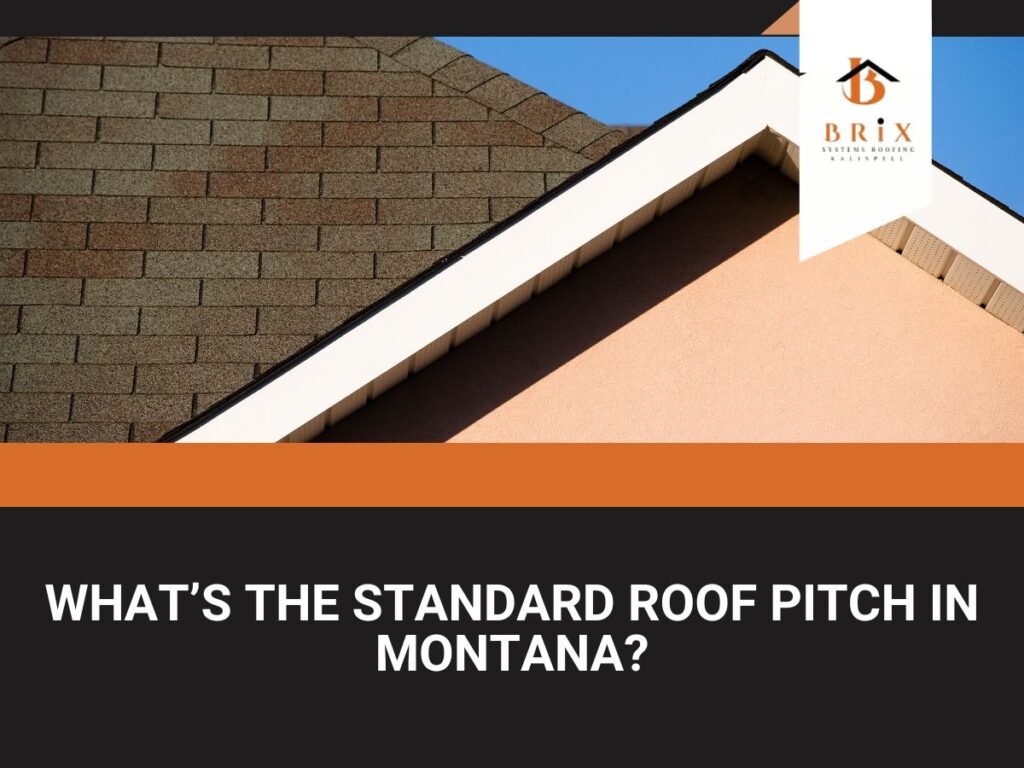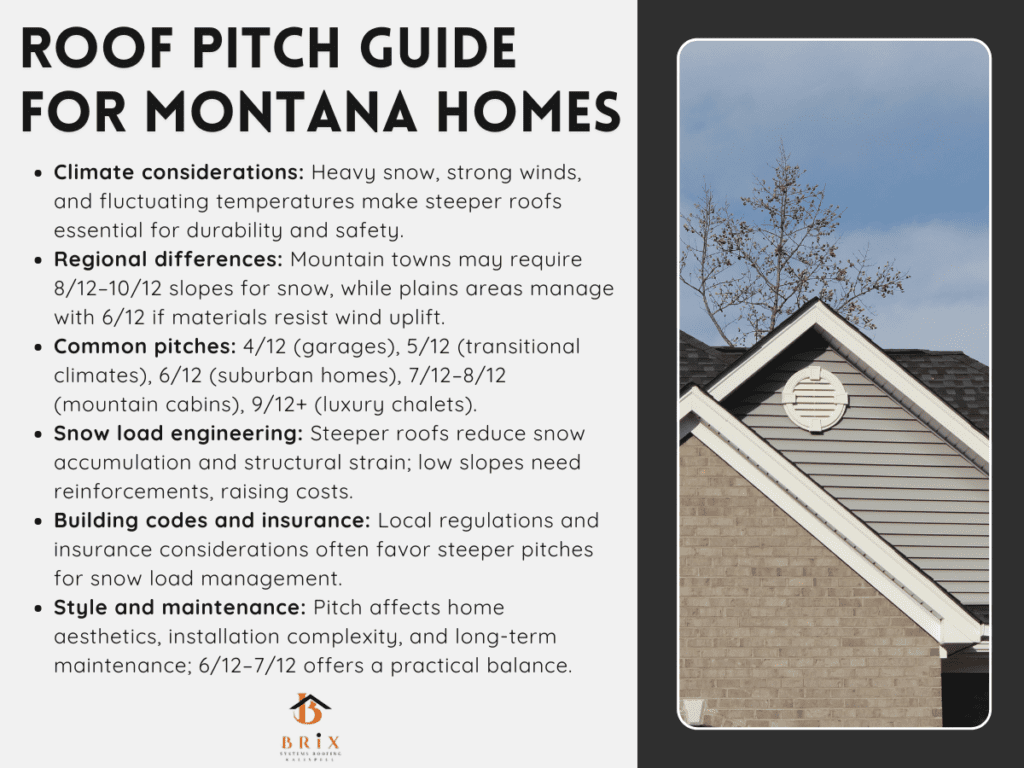
Snow-capped winters, sweeping winds, and long stretches of cold weather all shape how homes are built in Montana. One of the most important factors in roof construction here is the pitch, or slope, of the roof. Roof pitch is not just about style.
In Montana’s climate, it plays a big role in durability, snow shedding, and long-term maintenance costs. So what is the standard roof pitch in Montana, and why does it matter so much for homeowners and builders?
The standard roof pitch in Montana is about 5/12 to 6/12, meaning the roof rises 5–6 inches for every 12 inches of horizontal run. This range is considered the most common for homes across the state because it balances appearance, cost, and functionality.

Montana is known for its diverse weather. Winters bring heavy snow that can pile up quickly, while spring and summer often deliver storms with strong winds and rain. These conditions demand roofs that can shed snow efficiently and handle fluctuating loads without straining the structure. The climate in Montana makes roof pitch less of an aesthetic choice and more of a functional necessity.
A flatter roof may look modern but it traps snow, leading to ice dams, leaks, and structural stress. A steeper roof, on the other hand, helps snow slide off naturally, reducing risk of damage. Builders in Montana have to balance these considerations with the overall design of the home, making roof pitch one of the first decisions in construction planning.
Not every part of Montana has the same weather challenges. In the western mountain regions such as Missoula, Whitefish, and Big Sky, snow can pile several feet high in a single storm. Here, steep roof pitches are not optional, they are essential. By contrast, Eastern Montana towns like Miles City or Glendive receive less annual snowfall but face stronger winds sweeping across the plains. Wind-resistance matters as much as snow-shedding ability in those areas.
Roof pitch in Montana varies slightly by region, but the unifying factor is always resilience against snow and wind. While western mountain towns push toward 8/12 or even 10/12 pitches, eastern plains can manage with 6/12 slopes provided the materials and installation are strong enough to withstand wind uplift.
Across Montana, roof pitches generally fall between 6/12 and 9/12. In roofing terms, that means the roof rises 6 to 9 inches for every 12 inches of horizontal span. These steeper slopes are preferred because they shed snow more quickly than shallower designs. The most common standard roof pitch in Montana is around 6/12 to 8/12, as it balances safety, snow load management, and cost. Let’s break down the options:
| Pitch | Rise/Run | Pros | Cons | Best For |
| 4/12 | 4 inches rise for 12 inches run | Lower cost, easier to walk on | Poor snow shedding, risk of leaks | Garages, mild areas |
| 5/12 | 5 inches rise | Slightly better snow performance, affordable | Still prone to ice dams | Transitional climates |
| 6/12 | 6 inches rise | Standard in Montana, balances snow shedding and cost | Steeper maintenance than 4/12 | Suburban homes |
| 7/12–8/12 | 7–8 inches rise | Excellent snow shedding, attractive on cabins | More labor-intensive to install | Mountain towns |
| 9/12+ | 9 or more inches rise | Superior snow management, iconic A-frame style | Expensive, difficult access | Luxury cabins, chalets |
This breakdown shows why Montana homes rarely use shallow pitches. A 4/12 slope may work in California, but in Montana it invites water problems. Homeowners here lean toward the middle-to-high range for durability.
When determining roof pitch in Montana, one of the most important calculations is snow load. Snow load is the weight of snow that accumulates on a roof and is expressed in pounds per square foot. Engineers use regional maps and local codes to estimate the design snow load for a specific home.
For example, in Bozeman, snow loads can exceed 70 pounds per square foot, while in mountain resorts like Big Sky, loads may top 100 pounds per square foot. By contrast, Billings or Helena may see lighter averages. Steeper pitches are designed to reduce the load a roof must carry by helping snow slide off naturally.
If a homeowner insists on a low-pitch or flat design, engineers must add reinforcements. This often includes stronger trusses, steel framing, or specialized roofing materials designed to resist water infiltration. While these reinforcements are effective, they add significant cost. That is why many Montana builders recommend sticking with the tried-and-true 6/12 or 8/12 pitch.
Montana’s building codes also influence roof pitch standards. While not every county has identical requirements, many municipalities require roofs to be designed for specific snow loads. In mountain regions like Whitefish, steep pitches may be practically mandated.
Local building codes often push roof designs toward steeper pitches to protect homes from the weight of snow. This means that even if a homeowner prefers a flatter, modern aesthetic, they must either compromise or pay for expensive engineering modifications.
In addition to codes, insurance companies play a role. Homes with roofs more prone to snow damage may face higher premiums. A steep pitch not only satisfies local requirements but can also save money on long-term insurance costs.
Beyond codes and climate, roof pitch is also about the look and feel of a Montana home. Cabins with steep A-frame roofs are a common sight in the mountains, built that way as much for charm as for function. Farmhouses across the state often use 6/12 or 7/12 slopes, giving them a traditional yet functional style.
Modern architecture has introduced lower slopes into urban neighborhoods in places like Missoula and Billings. However, these designs often rely on reinforced materials, snow guards, and advanced insulation to ensure safety. Roof pitch in Montana is where practicality and aesthetics meet, shaping homes that are both resilient and beautiful.
The variety shows how homeowners balance tradition, innovation, and regional needs while still respecting the climate.
Cost is another key factor when choosing roof pitch. Steeper roofs require more materials, more labor, and sometimes specialized equipment for safe installation. A 6/12 pitch might be relatively straightforward, while a 10/12 pitch can double the labor hours required.
The steeper the roof, the higher the upfront cost, but the lower the long-term maintenance risk. A roof that sheds snow naturally will require fewer repairs for leaks, ice dams, and water intrusion.
Maintenance is also easier on shallower slopes. Roofing contractors can walk safely on a 4/12 or 5/12 pitch, but they need safety harnesses and scaffolding for anything 8/12 and steeper. This means repair costs rise over time, even though repairs may be less frequent.
Homeowners need to weigh upfront investment versus long-term savings. Many Montanans ultimately choose the middle ground of 6/12 or 7/12, which is safe, durable, and not prohibitively expensive.
For homeowners building or remodeling in Montana, the decision often comes down to three main factors: climate, budget, and style. In areas with heavy snowfall, a steeper pitch is generally the safest choice, since it allows snow to slide off naturally and prevents excessive weight from straining the roof structure.
For those drawn to a more modern aesthetic with a lower slope, it is important to budget for reinforcements, snow guards, and proper drainage systems to make the design practical in Montana’s winters. Local building codes also play a major role, as they outline the minimum standards needed to ensure roofs can withstand regional snow loads.
Working with an experienced contractor who understands Montana’s unique climate is essential to strike the right balance. A carefully chosen roof pitch can save thousands in repairs and protect your home for decades, making it one of the most valuable long-term investments in your property.
When weighing roof pitch options in Montana, consider the following:
These choices ensure your home remains safe, efficient, and valuable over time.
In Montana, the standard roof pitch typically ranges between 6/12 and 8/12, reflecting the need to shed snow while keeping construction practical. Homeowners and builders in this state do not choose roof slopes only for looks.
Instead, they are making decisions that affect safety, comfort, and costs over decades. A roof designed for Montana’s weather is more than a covering. It is a shield that ensures homes stand strong against snow, wind, and time.